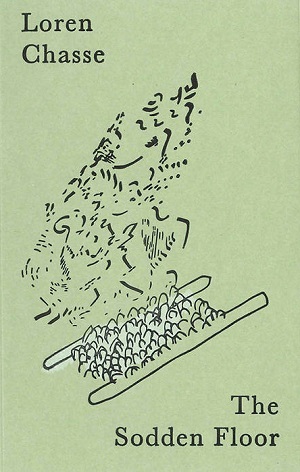 Presence and absence is a musically black and white affair. Either an instrument is present or it isn’t. A sound is buried in the mix or it’s up front and unavoidable. A recording can be clear or murky, not both, and though there are degrees of difference, those degrees exist exclusively on the presence side of the scale. The Sodden Floor, released last year by Loren Chasse in an edition of 100 cassettes, introduces shades of grey to that dichotomy. Over four songs, Chasse combines vaporous field recordings—of pipes, running water, stones, and humming glass—with abstract and sometimes eerie instrumental performances, on bells, drums, guitar, and melodeon. The low-key, atmospheric result is like listening to someone else’s dream. There’s heat and texture to the sights and sounds, but they are implied more than felt, veiled and kept out of reach behind layers of steam and oxidized memories.
Presence and absence is a musically black and white affair. Either an instrument is present or it isn’t. A sound is buried in the mix or it’s up front and unavoidable. A recording can be clear or murky, not both, and though there are degrees of difference, those degrees exist exclusively on the presence side of the scale. The Sodden Floor, released last year by Loren Chasse in an edition of 100 cassettes, introduces shades of grey to that dichotomy. Over four songs, Chasse combines vaporous field recordings—of pipes, running water, stones, and humming glass—with abstract and sometimes eerie instrumental performances, on bells, drums, guitar, and melodeon. The low-key, atmospheric result is like listening to someone else’s dream. There’s heat and texture to the sights and sounds, but they are implied more than felt, veiled and kept out of reach behind layers of steam and oxidized memories.
Memory is a good place to begin with The Sodden Floor. It was recorded in Portland, Oregon between 2011 and 2014, but the now sold out cassette (still available in digital format) wasn’t released until October of 2015, which means there was considerable distance between at least some of the recordings and the arrangement of the material. Furthermore, despite using multiple instruments, Chasse lists only his great grandmother’s melodeon in the liner notes, an instrument built in 1867 by, appropriately enough, Horace Waters & Co. Before the music begins, history, memory, and family are already a part of the proceedings.
Set the tape to spinning and those topics are all magnified, or diminished depending on how you look at it. Except for a few passages of melody played on a guitar and what might be a cello, everything Chasse presents, he presents from a distance. Sounds are pale or faded, soaked in a remote pallor that insinuates temperature and texture without actually transmitting either. It’s a music haunted by sounds and the things that made them, by wind and breath and slow movements through spaces lined with dirt and plant life. Bells, which Chasse utilizes prominently in a couple of sections, don’t simply resonate against a dead background, they ring out in a place that seems like it should smell of stone and wet earth. Solitary notes on the guitar drift by like clouds and the meandrous melodeon phrases bubble up and down as if carried by a stream. Just as they are about to solidify, just as it appears they are within arm’s reach, the momentum of the music—and the momentum of those strange environmental noises—carries them away and they recede into the fog.
Also included in the liners is a brief uncredited poem written like an ode to watery decay. The concluding couplet reads, "Cut all ropes to the shore/Leave me be upon this sodden floor." If Chasse envisioned The Sodden Floor as a final drifting out to sea, he halfway achieved it. Halfway because semblances of the shore are still in evidence. Some of the beauty and melancholy of the recording subsists in its transitory character and in the feeling that none of the events and objects captured on the tape can be recovered. They are as absent as they are present, part physical phenomenon and part phantom.
There is, however, room for endurance. The music is capable of seeping into the air and into our skin, and like family and friends, can persist through all manners of change. They survive as ghosts, present and absent in what we see and hear. But it may be that ghosts are just as real as that stone or that drum or that old melodeon, built by Horace Waters & Co. in 1867.
samples:
 
Read More

